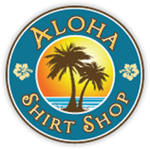Warm balmy breezes and white sandy beaches. The crystal blue waters of the Pacific reflecting golden sunsets. Symbols of the islands of Hawaii. As symbolic as any Hawaiian treasure is the Hawaiian shirt, or properly described, the "Aloha shirt". The lore and history of the first "Aloha" Hawaiian shirts is steeped in the culture and heritage of early Hawaii.
Hawaii's history is filled with legends, and many of them were wearing Hawaiian shirts. On the islands, they are known as Aloha shirts but the icon known as the Hawaiian shirt is a trademark recognized worldwide. The Hawaiian Aloha shirt is a symbol of the island paradise Hawaii as well as its contemporary history.
In the early 20th century Hawaii experienced an influx of immigrants from Asia and the United States. This was plantation-era Hawaii and the economy was centered on sugar cane and pineapple export. In addition to language and traditions, immigrants brought with them a variety of cloth and clothing styles. Bright Kimono fabric came from Japan, Barong style shirts came from the Phillippines, formal silk garments from China and the collared shirt came from the United States. Native Hawaiians had traditional clothing made with colorful geometric patterns often seen on Kapa Pa'u (sarongs).
During this time, in 1920s and 1930s, plantation workers were seen in short sleeved shirts with bright geometric patterns. These were known as Palaka shirts. Often, Japanese men and boys on the islands wore a similar style shirt made from left over Kimono cloth, the Kimono-cloth shirt. These early precursors to the modern Hawaiian Aloha shirt were every day staples in the wardrobes of plantation workers.
In 1931, a young college graduate named Ellery Chun returned to Hawaii after attending school in Connecticut. It was during the Great Depression and Chun went to work for his father's dry goods store in Honolulu. Chun soon took over the business, renamed the store King-Smith Clothiers and began expanding. He enlisted the help of his sister, Ethel Chun Lum, and began making bright print short sleeve shirts made out of the leftover material from Japanese Kimonos. Chun registered the trade name "Aloha" in 1936 and a print ad in the Honolulu Advertiser Newspaper was where he first coined the phrase "Aloha shirt". Chun displayed the Hawaiian Aloha shirts in his shop window and catapulted the Palaka into fashion history the Hawaiian Aloha shirt.
Around the same time that Chun trademarked the Hawaiian Aloha shirt another Honolulu business was also making short-sleeved shirts from Japanese Kimono fabric. Musashiya and Surfriders Sportswear, in Honolulu's Ala Moana Shopping Center, sold the colorful garments as "Hawaiian" shirts. Both Chun and Musashiya sold shirts with ornate prints, palm trees, hula girls, pineapples and just about every other image of Hawaii.
Both manufacturers had envisioned a hot commodity and the modern Hawaiian Aloha shirt was born. The shirts were purchased by local residents, beach boys, surfers and island visitors. Tourists to the islands fell fast for the fad of the brightly colored shirts donned by young islanders. Chun began sponsoring a local radio talent show from the Moana Surfrider Hotel, giving even more acceleration to the popularity of the Hawaiian Aloha shirt. His sister, Ethel, began creating bright tropical fabric patterns that defined Hawaiian designs vs. Asian styles establishing the modern Hawaiian shirt for men.
Other merchants followed Chun's and Musashiya's leads. Soon, Hawaiian shirts were produced across the islands in endless styles. Paintings were transferred to fabric and designs competed for most elaborate and most ornate. Even the labels became works of art that emulated the dream of life on the Hawaiian Islands with their "Made in Hawaii" stamps.
Post World War II the shirt's colorful, exotic prints were in even higher demand from tourists who traveled by cruise ship to the islands to the tropical destinations they'd seen on Hollywood screens. By this time, the Hawaiian Aloha shirt had found fame worn by Elvis Presley, John Wayne, Frank Sinatra, and several presidents including Harry S. Truman. The shirts graced movie screens including "From Here to Eternity" and secured a place in history as a Hollywood fashion trend. In 1960, one of the largest garment manufacturers in Hawaii, Kamehameha Garment Company, shipped 35 tons of Aloha shirts to mainland United States.
True Hawaiian Aloha shirts are like paintings of paradise and the fabric is a canvas for the rich images of the islands but by mid 20th century, imitation Hawaiian shirts started cropping up on the mainland for mass production. Designs became washed out versions of the intricate originals. Thankfully our manufactures have continued on with the original Aloha that was conceived in the beginning of the creation of the Aloha shirt.
Through the decades countless designs gave the Hawaiian Aloha shirts their appeal. A great loss is that many have been forgotten to history. Original shirts with original labels are collector's items, sometimes worth thousands of dollars. Although neither Chun nor Musashiya truly invented the garment, their entrepreneurial endeavors made the Hawaiian Aloha shirt a global.
Ellery Chun closed King-Smith Clothiers in the 1960s but lived long after watching the marketing journey of the shirt he helped make famous. Musashiya and Surfriders Sportswear is still in business in Honolulu's Ala Moana Shopping Center. Both created a fashion icon that seems here to stay. The Hawaiian Aloha shirt is still one of the best souvenirs of a tropical land, just be sure the one in your closet has true Aloha from Aloha Shirt Shop.


